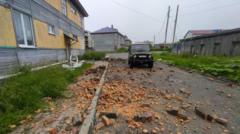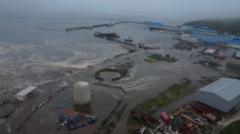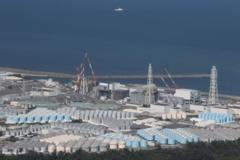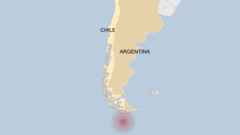Despite the quake's strength, factors such as ocean depth, early warning systems, and geographical features contributed to a limited tsunami impact.
**Mega Earthquake in Russia: Minimal Tsunami Impact Explained**

**Mega Earthquake in Russia: Minimal Tsunami Impact Explained**
An 8.8 magnitude earthquake strikes Russia's Kamchatka Peninsula, prompting tsunami fears but resulting in less damage than anticipated.
The recent 8.8 magnitude earthquake in Russia's Kamchatka Peninsula surprised many by not triggering the devastating tsunami that was initially feared. The earthquake occurred at 11:25 local time on Wednesday (00:25 BST) and raised concerns for coastal populations across the Pacific. In light of past tsunami disasters, such as those following major earthquakes in 2004 and 2011, millions were evacuated.
Yet, even with significant local damage, the tsunami waves were notably less severe. To understand why, experts point to several factors associated with the nature of earthquakes and tsunamis. The Kamchatka Peninsula is situated in the "Pacific Ring of Fire," a zone known for its tectonic activity, where the Pacific plate moves north-west and interacts with the Okhotsk microplate. This interaction can cause stress to accumulate over time and release suddenly in the form of earthquakes.
Dr. Stephen Hicks, a lecturer in environmental seismology at University College London, explained the mechanics of large earthquakes. These occur when fault lines ruptured along extensive distances, leading to significant seismic activity. Yet, not every powerful earthquake generates equally powerful tsunamis due to how they displace water when they occur.
Today's earthquake resulted in tsunami waves of about 4 meters (13 feet), which although notable, were far less impactful than those seen in previous tsunami events. Dr. Hicks noted that local seafloor shapes and coastal landforms also influence tsunami wave heights.
Another contributing factor to the minimal tsunami impact is the earthquake's depth, which was recorded at a relatively shallow level of about 20.7 km (12.9 miles). Though a more profound earthquake could potentially create larger tsunami waves, evaluations are ongoing, and initial estimates may not fully reflect the event's impact.
The role of modern early warning systems cannot be understated. Many countries in the Pacific have developed robust tsunami warning systems to help manage risks. In contrast, no such system was in place during the catastrophic Boxing Day tsunami of 2004, which resulted in over 230,000 fatalities. This earthquake's precursors included a smaller 7.4 magnitude quake just days prior, underlining the complexity of predicting tectonic activity.
The Geophysical Survey of the Russian Academy of Sciences (GS RAS) is monitoring the aftermath, as experts anticipate potential aftershocks in the upcoming month. They continue to study the factors that influenced the tsunami’s limited impact, ensuring better preparedness for future seismic events.
Yet, even with significant local damage, the tsunami waves were notably less severe. To understand why, experts point to several factors associated with the nature of earthquakes and tsunamis. The Kamchatka Peninsula is situated in the "Pacific Ring of Fire," a zone known for its tectonic activity, where the Pacific plate moves north-west and interacts with the Okhotsk microplate. This interaction can cause stress to accumulate over time and release suddenly in the form of earthquakes.
Dr. Stephen Hicks, a lecturer in environmental seismology at University College London, explained the mechanics of large earthquakes. These occur when fault lines ruptured along extensive distances, leading to significant seismic activity. Yet, not every powerful earthquake generates equally powerful tsunamis due to how they displace water when they occur.
Today's earthquake resulted in tsunami waves of about 4 meters (13 feet), which although notable, were far less impactful than those seen in previous tsunami events. Dr. Hicks noted that local seafloor shapes and coastal landforms also influence tsunami wave heights.
Another contributing factor to the minimal tsunami impact is the earthquake's depth, which was recorded at a relatively shallow level of about 20.7 km (12.9 miles). Though a more profound earthquake could potentially create larger tsunami waves, evaluations are ongoing, and initial estimates may not fully reflect the event's impact.
The role of modern early warning systems cannot be understated. Many countries in the Pacific have developed robust tsunami warning systems to help manage risks. In contrast, no such system was in place during the catastrophic Boxing Day tsunami of 2004, which resulted in over 230,000 fatalities. This earthquake's precursors included a smaller 7.4 magnitude quake just days prior, underlining the complexity of predicting tectonic activity.
The Geophysical Survey of the Russian Academy of Sciences (GS RAS) is monitoring the aftermath, as experts anticipate potential aftershocks in the upcoming month. They continue to study the factors that influenced the tsunami’s limited impact, ensuring better preparedness for future seismic events.




















